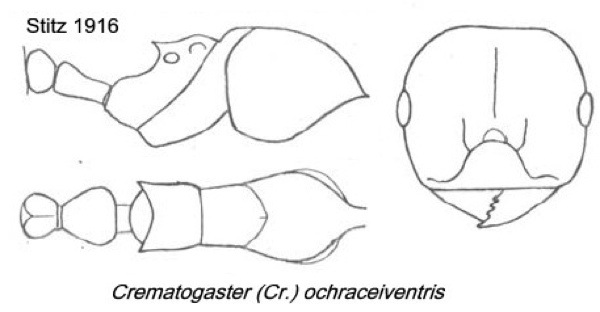 Translation by
Hauke Koch - Translation by
Hauke Koch -
WORKER: TL 3.5 mm; head slightly wider than long, the sides convex;
occipital corners very much rounded, the hind-margin straight, slightly
depressed to the middle (barely noticeable). Eyes in the middle of the
sides of the head. Frontal carinae parallel, as long as their distance
from the midline of the head, which runs as a fine groove to the
occiput (conspicious in lateral view). Frons inconspiciously bordered.
Clypeus semicircular at the back, with straight frontal margin, which
is slightly depressed in the middle. Mandibles with four teeth. Scape,
when aligned to the head, surpassing the occiput by less than their own
width. Funicular joints 3 and 4 as long as wide, the following joints
getting longer, the penultimate 2 joints twice, the last thrice as long
as wide at the base, all three forming a strongly developed club.
Promesonotum, viewed laterally, at the top shallowly convex, descending
equally inclined and with a strong curvature to the front and back.
Metanotal groove with both sides aligned in a blunt, almost rectangular
angle. Pronotum in its greatest width more or less one quarter wider
than long in the midline, its curvature transversely shallower than
longitudinally; its convex lateral margins are angular and rounded,
forming a blunt shoulder below which the lateral areas are somewhat
depressed; parallel to the margin below each shoulder there is a small
longitudinal welt. The mesonotum is separated from the pronotum by an
inconspicious, anteriorly moderately convex, slightly depressed suture;
its frontal median part is slightly elevated and projects tonguelike
into the pronotal area; in the middle of this tongue lies near the
frontal suture a minute humplike elevation, reminding of the rest of a
keel, which can be seen best when viewed diagonally from the front and
from above. The lateral margins of the mesonotum are angularly rounded,
almost parallel and only weakly converging posteriorly; dorsally
somewhat longer than its greatest width; the basal part transversely
shallowly convex; the decline following without distinct border, it is
even, to both sides acutely angularly bordered and amounts for circa
1/3 of the length of the whole mesonotum. The dorsum of the propodeum
is 1/3 wider than long and to both directions shallowly convex, but
anteriorly at the mesonotal suture shallow and proceeds without
distinct border to the declivity. The spines are short, almost
denticular, coming from a relatively broad ground, but sharpening
rapidly; in lateral view they are aligned with the dorsum of the
propodeum, from which they are slightly angled basally; when viewed
from above, the apices are diverging moderately; the propodeal spiracle
at the base of the spines is large. Petiole a triangle with broadly cut
hind-apex, convex base and to both sides heavily rounded corners, the
sides straight. Viewed from above, the area is wider than long, a
quarter wider than the postpetiole, in the frontal part even,
transversely weakly concave, with sharp-edged margins, without a
ventral tooth. Postpetiole dorsally with a deep impression, which
becomes a deep groove anteriorly.
Mandibles and clypeus very finely and densely
longitudinally striated, also the angles of the frontal lobes bordering
on the antennal grooves and the genae, this sculpture proceeding weakly
on the ventral side of the head in these areas, then getting lost.
Otherwise the head is smooth, very shiny, with not very dense
microscopical points, each bearing a hair. All dorsal areas of the
thorax finely and densely rugosely punctuated. The lateral mesonotum
and propodeum show the same sculpture as their dorsal area; the sides
of the pronotum are smooth and shiny, only weakly rugosely punctuated
at the front. Both petiole and postpetiole dorsally finer punctuated
but more finely than the alitrunk. Gaster smooth, shiny, with
microscopic fine points. The area of the head, according to the
punctuation, with fine appressed grey hairs, the same on the scape,
slightly longer and erect on the funiculus and the mandibles. Clypeal
margin with a row of longer hairs. Alitrunk, petiole, postpetiole and
gaster with few erect hairs; on the alitrunk these are short, on the
petiole and postpetiole slightly longer, on the gaster short, fine,
appressed and arising from puncturations. Femora and tibiae with sparse
appressed hairs. Head, scape, alitrunk and legs brown, the genae and
funiculus lighter. Abdomen yellow. 4 workers; French Congo (Fort
Crampel), 06.01.1911; Schubotz.
|